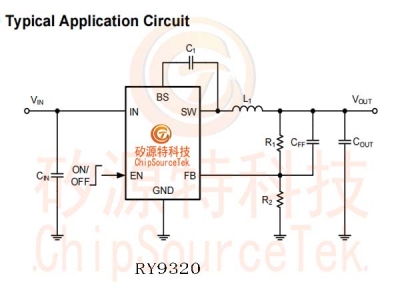RY9320 General Description:
The RY9320 is a high frequency, synchronous, rectified, step-down, switch-mode converter with internal power MOSFETs. It offers a very compact solution to provide a 2A continuous output current over a wide input supply range, with excellent load and line regulation. ECOT PSM control operation provides very fast transient response and easy loop design as well as very tight output regulation.
The RY9320 requires a minimal number of readily available, external components and is available in a space saving SOT23-6 package.
RY9320 Features:
Wide 4.5V to 28V Operating Input Range
2A Continuous Output Current
500KHz Switching Frequency
ECOT PSM Mode Control with Fast Transient Response
Built-in Over Current Limit
Built-in Over Voltage Protection
PFM Mode for High Efficiency in Light Load
Internal Soft-Start
100mΩ/50mΩ Low RDS(ON) Internal Power MOSFETs
Output Adjustable from 0.6/0.8/0.765V
No Schottky Diode Required
Short Protection with Hiccup-Mode
Integrated internal compensation
Thermal Shutdown
Available in SOT23-6 Package
-40°C to +85°C Temperature Range
RY9320 Applications:
Automotive Systems
Network Terminal Equipment
Security Monitoring Camera
Printer Systems
Industrial Power Systems
Distributed Power Systems
RY9320 Typical Application Circuit:

RY9320 Pin Description:

RY9320AT6 Top Marking: GaYLL (device code: Ga, Y=year code, LL=lot number code)
RY9320BT6 Top Marking: GqYLL (device code: Gq, Y=year code, LL=lot number code)
RY9320CT6 Top Marking: GsYLL (device code: Gs, Y=year code, LL=lot number code)
RY9320 Pin Description:

RY9320 Order Information (1):
|
Marking
|
Part No.
|
Model
|
Description
|
Package
|
T/R Qty
|
|
GaYLL
|
70301511
|
RY9320AT6
|
RY9320AT6 ECOT PSM Buck, 4.5-28V,
2A, 500KHz, VFB 0.6V, SOT23-6
|
SOT23-6
|
3000PCS
|
|
GqYLL
|
70301512
|
RY9320BT6
|
RY9320BT6 ECOT PSM Buck, 4.5-28V,
2A, 500KHz, VFB 0.8V, SOT23-6
|
SOT23-6
|
3000PCS
|
|
GsYLL
|
70301513
|
RY9320CT6
|
RY9320CT6 ECOT PSM Buck, 4.5-28V,
2A, 500KHz, VFB 0.765V, SOT23-6
|
SOT23-6
|
3000PCS
|
RY9320 Functional Block Diagram:


















